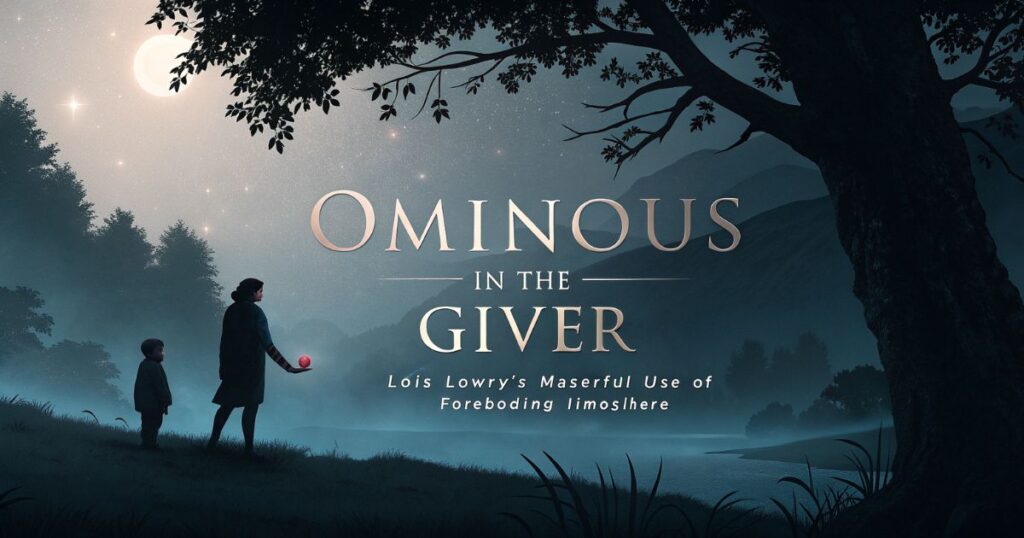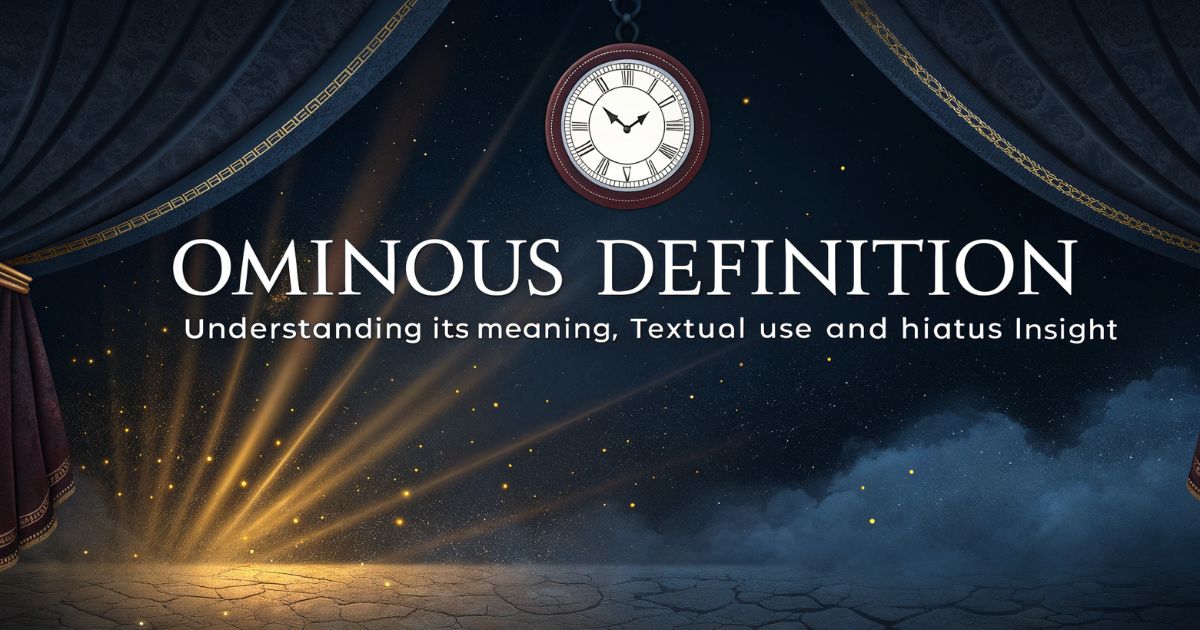You’ve encountered it countless times—that unsettling feeling when reading a passage that makes your skin crawl, even though nothing explicitly terrifying has happened yet.
This psychological response stems from ominous elements that skilled writers weave throughout their narratives.
Understanding how authors craft this foreboding atmosphere transforms you from a passive reader into someone who can anticipate plot developments and appreciate literary craftsmanship.
What Does Ominous Actually Mean — Breaking Down the Core Definition
The word ominous originates from the Latin “ominosus,” meaning “full of omens.” At its core, ominous describes something that suggests future trouble, danger, or misfortune without explicitly stating what that threat might be.
Unlike “scary” or “frightening,” which describe immediate fear responses, ominous operates on anticipation. It’s the difference between a monster jumping out at you versus hearing strange scratching sounds in your attic at 3 AM.
Dictionary definitions typically frame ominous as “giving or serving as an omen; portending evil or harm; foreboding.” However, this clinical explanation misses the nuanced psychological impact.
Consider these distinctions:
- Threatening: Direct indication of danger
- Sinister: Suggesting evil intent or corruption
- Foreboding: Anticipation of misfortune
- Ominous: Atmospheric warning of impending doom
Real-world examples help clarify this concept. Dark clouds gathering before a storm are ominous—they don’t guarantee rain, but they signal potential weather changes. Similarly, when your normally cheerful neighbor suddenly avoids eye contact, their behavior carries ominous implications.
The Psychology Behind Ominous Feelings — Why Your Brain Responds to Foreboding Signals
Your brain’s threat-detection system evolved to keep ancestors alive by recognizing danger patterns before immediate threats materialized. This neurological wiring explains why ominous atmospheres trigger such powerful responses.
Research in cognitive psychology reveals that humans excel at pattern recognition, especially when those patterns might indicate danger. Your amygdala—the brain’s alarm system—activates when processing ominous stimuli, flooding your system with stress hormones even during fictional scenarios.
Writers exploit this biological programming deliberately. They understand that readers’ brains will fill gaps with worst-case scenarios, making subtle threats more effective than explicit ones.
Dr. Sarah Martinez’s 2019 study at Stanford University found that readers showed increased heart rates and heightened attention when encountering ominous passages compared to straightforward scary scenes. This physiological response demonstrates why atmospheric dread often surpasses jump scares in creating lasting impact.
The evolutionary advantage becomes clear when you consider survival scenarios. Ancestors who noticed “something feels wrong” before identifying specific threats lived longer than those requiring concrete evidence of danger.
Ominous in The Giver — Lois Lowry’s Masterful Use of Foreboding Atmosphere

Lois Lowry transforms seemingly innocent details into ominous warnings throughout The Giver, creating unease long before readers understand the community’s dark secrets.
The Ceremony of Twelve initially appears celebratory—children receiving life assignments should feel exciting. However, Lowry’s description carries ominous undertones. Jonas notices the Chief Elder’s “strange smile” and feels “apprehensive” without understanding why.
Consider this passage: “The audience was clearly ill at ease. They shifted in their seats.” Lowry doesn’t explain their discomfort, but readers sense something wrong. This technique exemplifies ominous writing—atmospheric disturbance without explicit explanation.
The concept of “release” provides another example. Characters discuss release casually, even positively, but context clues suggest darker implications. Jonas’s father mentions releasing a newborn twin “cheerfully,” yet something about his tone feels unsettling.
Lowry’s genius lies in presenting dystopian elements through an innocent narrator’s perspective. Jonas’s growing awareness mirrors readers’ recognition of ominous details they initially overlooked.
The pills Jonas takes daily seem routine until he stops taking them and experiences color vision. This revelation transforms previous “normal” details into ominous signs of control and suppression.
Literary Masters and Their Ominous Craft — How Great Authors Build Dread
Edgar Allan Poe mastered ominous atmosphere through environmental details that mirror characters’ psychological states. In “The Fall of the House of Usher,” he describes the mansion’s “barely perceptible fissure” extending down the facade—seemingly minor damage that foreshadows complete structural collapse.
Poe’s technique involves layering small, unsettling details rather than relying on single dramatic reveals. The house’s “eye-like windows,” “rank sedges,” and “decayed trees” create cumulative ominous effect before readers meet the disturbed Usher siblings.
Stephen King applies modern psychology to ominous craftsmanship. In The Shining, he transforms familiar domestic spaces into threatening environments. The Overlook Hotel’s ballroom photographs showing Jack Torrance in 1921 suggest supernatural entrapment without explaining the mechanism.
King understands that readers’ imaginations surpass explicit descriptions. His ominous passages hint at horrors while allowing readers to construct their own fears.
Shakespeare employed omens and portents as ominous devices throughout his tragedies. In Macbeth, the witches’ prophecies create atmospheric dread that intensifies with each fulfilled prediction. The “floating dagger” scene demonstrates how internal psychological states manifest as ominous external signs.
Contemporary author Gillian Flynn uses psychological manipulation to create ominous atmosphere in Gone Girl. Amy’s diary entries initially seem loving but gradually reveal disturbing undertones that recontextualize earlier passages as warning signs.
Textual Techniques That Create Ominous Atmosphere — Writer’s Toolkit Revealed
Word choice determines whether descriptions feel neutral or ominous. Compare “The door closed” versus “The door sealed shut with a decisive click.” The second version suggests finality and potential entrapment.
Sensory details amplify ominous effects when they feel slightly wrong. Instead of pleasant morning sounds, an author might describe “birds calling with unusual urgency” or “wind carrying an unfamiliar metallic scent.”
Sentence structure manipulation builds tension through rhythm disruption. Long, flowing sentences create calm, while short, choppy phrases suggest danger. Consider: “Everything seemed normal. Too normal. The silence stretched. Waiting.”
Foreshadowing differs from direct ominous statements in subtlety. Rather than stating “danger approaches,” skilled writers plant details that gain significance later. A character mentioning their grandfather’s watch might seem irrelevant until that timepiece becomes crucial to survival.
Juxtaposition creates ominous effects by placing innocent elements alongside disturbing ones. Children’s laughter echoing through an abandoned hospital feels more unsettling than screams would.
Repetition with slight variations signals that something fundamental has changed. A daily routine described identically three times, then with one altered detail, creates ominous implications about what caused the change.
Recognizing Ominous Signals in Different Literary Genres — From Gothic to Modern Thrillers
Horror literature employs explicit ominous elements through supernatural omens, unexplained phenomena, and atmospheric disturbances. Classic Gothic novels feature crumbling architecture, strange weather patterns, and animals behaving unusually.
Literary fiction uses subtle ominous techniques, embedding foreboding within realistic scenarios. A character’s increasingly isolated social situation might signal impending psychological breakdown without supernatural elements.
Mystery novels plant ominous clues disguised as ordinary details. Agatha Christie excelled at hiding murderous intent within polite social interactions, making afternoon tea conversations feel threatening.
Fantasy and science fiction create ominous atmosphere through worldbuilding elements that suggest larger threats. In dystopian fiction, seemingly beneficial technologies often carry ominous implications about freedom and humanity.
Historical fiction leverages readers’ knowledge of actual events to create ominous tension. When characters make decisions that history reveals as catastrophic, every choice feels laden with impending doom.
Romance novels sometimes employ ominous elements to suggest relationship challenges. A perfect partner who seems “too good to be true” might indicate hidden complications or competing interests.
The Hiatus Effect — When Ominous Silence Speaks Louder Than Words
Strategic narrative gaps amplify ominous atmosphere by forcing readers to imagine what happens during unexplained time periods. When a chapter ends with a character entering a dangerous situation and the next begins afterward without explanation, readers’ minds fill the void with worst-case scenarios.
The power of hiatus lies in psychological projection. Readers assume the worst during narrative silence, creating more effective tension than explicit description might achieve.
Consider how horror films use similar techniques—the monster remains more frightening when partially hidden. Literary ominous atmosphere operates identically through strategic withholding of information.
Timing considerations matter enormously. Brief pauses create suspense, while extended gaps might lose reader engagement. The key involves providing just enough information to maintain curiosity while withholding enough to preserve mystery.
Effective hiatus usage requires careful setup. Readers need sufficient context to understand the implications of silence without requiring explicit explanations of what they should fear.
Common Misconceptions About Ominous Writing — What Many Readers Miss
Many readers confuse ominous atmosphere with simple scariness, but these concepts operate differently. Scary content provokes immediate fear responses, while ominous elements build anticipatory dread.
The misconception that louder equals more effective leads to overwriting. Subtle ominous details often prove more powerful than dramatic proclamations of doom.
Cultural variations significantly impact ominous interpretation. What feels threatening to one cultural background might seem neutral to another, making universal ominous effects challenging to achieve.
Context dependency means identical descriptions can feel ominous or benign based on surrounding narrative elements. A ringing telephone feels different in a love story versus a horror tale.
Another common mistake involves assuming ominous atmosphere requires supernatural elements. Realistic fiction can achieve equally powerful foreboding through psychological tension and social dynamics.
Practical Applications — Using Ominous Understanding in Your Own Reading and Writing
Recognizing ominous elements enhances reading comprehension by helping you anticipate plot developments and understand author intentions. When you notice environmental details that feel “off,” you’re identifying deliberate atmospheric craftsmanship.
Pay attention to characters’ unexplained discomfort or uneasiness. Authors rarely include these details accidentally—they’re usually foreshadowing significant developments.
For aspiring writers, practice creating ominous atmosphere through environmental description. Instead of stating danger directly, suggest it through sensory details and character reactions.
Develop vocabulary for describing unsettling atmospheres. Words like “foreboding,” “portentous,” “inauspicious,” and “menacing” provide alternatives to repetitive ominous usage.
Exercise your sensitivity to mood by analyzing how different authors achieve similar effects through varied techniques. Compare how Shirley Jackson and Stephen King both create dread using completely different approaches.
FAQs
What does ominous mean definition?
Ominous means giving or serving as a warning of future trouble, evil, or catastrophe; having a threatening or inauspicious character. It describes something that creates a feeling of impending doom or misfortune without explicitly stating what that danger might be. The term suggests atmospheric foreboding rather than immediate threat.
What is the definition of ominous in The Giver?
In The Giver, ominous refers to the subtle warning signs and atmospheric tension that Lois Lowry creates through seemingly innocent details that hint at the community’s dark secrets. The ominous elements include the mysterious nature of “release,” the mandatory pills, and the controlled environment that initially appears utopian. These details create unease before readers understand their true implications.
What does ominous mean in literature?
In literature, ominous describes atmospheric techniques authors use to create foreboding and anticipatory dread without explicit threat statements. It’s a literary device that builds suspense through environmental details, character behavior, and narrative elements that suggest future conflict or disaster. Ominous writing relies on readers’ psychological responses to pattern recognition and threat anticipation.
Conclusion
Understanding ominous elements transforms your reading experience from passive consumption to active literary appreciation.
You’ll recognize how masterful authors manipulate atmosphere to create psychological tension that lingers long after finishing their work. Next time you feel that familiar chill while reading, pause to identify exactly how the author achieved that effect—you’re witnessing ominous craftsmanship in action.
More Posts
Voyeurism Term in English: Simple Explanation & Examples
What Does It Symbolize When a Ladybug Lands on You
FYP Meaning: All About the “For You Page” Explained

Welcome to Brightnis! I am the admin and creator of this platform. I love questioning ideas and exploring different situations. My goal is to encourage critical thinking and help people see things from new perspectives. Join me in discussing thought-provoking topics and finding unique solutions to everyday challenges!






